- Home
- Oliver Sacks
Hallucinations Page 9
Hallucinations Read online
Page 9
When I saw her in 2011, I asked her what her hallucinations were like. “Horrible!” she said. “It’s like watching a horror movie, and you’re part of it.” She saw little people (“Chuckys”) running around her bed at night; they seemed to be talking to each other, she saw their gestures and their lips move, but she could not hear any speech. On one occasion she tried to speak to them. Although they looked frightening and (she thought) had evil intentions, they never molested or approached her, though once one of them sat on her bed. But far worse were certain scenes enacted before her. “I saw my son murdered right in front of my eyes,” she told me. (“It was Darkside stuff,” her husband interpolated.) Once, when her husband visited, she said, “What are you doing here? They just had your funeral at Sacred Heart Church.” She often saw rats, and sometimes felt them in her bed. She also felt “fish” nibbling at her feet. Sometimes she had hallucinations of being part of an army marching into battle.
When I asked if she had any pleasant hallucinations, she said that she had sometimes seen people “in Hawaiian dress” in the corridor or outside her window, getting ready to play music for her, though she never actually heard any music. What she did hear, however, were various noises—especially the sound of running water. No voices. (“Good thing I didn’t have those,” she said, “or they’d think I was really crazy.”) There have been some olfactory hallucinations, too: “people around me with different kinds of scents.”
When her hallucinations started, Mrs. B. was understandably terrified, and took them for reality—“I did not even know the word ‘hallucination,’ ” she said. Then she found herself more able to distinguish hallucinations from reality, but this did not prevent her from being frightened when they occurred. She always looked to her husband for reality testing; she would ask him whether he saw, heard, felt, or smelled some of the things she did. Sometimes she would have distortions of vision—her husband’s face would be disfigured by a down-curving, sneering smile or occasionally his mouth would be upturned, “like a smiley face.” A particularly strange and frightening hallucination occurred recently. There is a poster of a Native American chief hanging above her bed, and this came to life for Mrs. B. the other day; the chief stepped out of the frame and seemed to be standing in the bedroom. To reassure her, her husband waved his hands in front of the picture to dissipate the hallucination—and the chief seemed to disintegrate, but then she felt she was disintegrating, too. On another occasion, clothes in the bedroom “started walking around,” and she had to have her husband shake a pair of jeans to show that it was just this, and nothing more.
Hallucinations may also occur in other types of dementia, including moderately advanced Alzheimer’s disease, though less often than they do in Lewy body disease. In such cases, hallucinations may give rise to delusions, or they may stem from delusions. There may also be, in Alzheimer’s or other types of dementia, delusions of duplication or misidentification. One patient of mine, sitting next to her husband on an airplane, suddenly saw him as “an imposter” who, she believed, had murdered her husband and was now trying to take his place. Another patient of mine, while she recognized the nursing home she was in by day, felt that she had been transferred to a cunning “duplicate” of the home each night. Sometimes psychoses can be centered on delusions of persecution, and occasionally these lead to violent behavior: one such patient assaulted a harmless neighbor, whom she felt was “spying” on her. Hallucinations in Alzheimer’s disease, like those of Lewy body disease, are usually embedded in a complex matrix of sensory deceptions, confusion, disorientation, and delusions, and are rarely isolated, “pure” phenomena as in Charles Bonnet syndrome.
I worked for many years with the eighty deeply parkinsonian postencephalitic patients I described in Awakenings. Many of them had been “frozen” for decades, virtually immobilized by their disease. Once I got to know them well (after they had been enabled to move and talk by L-dopa), I found that perhaps a third of them had experienced visual hallucinations for years before L-dopa was introduced—hallucinations of a predominantly benign and sociable sort. I was not sure why they hallucinated in this way, but I thought it might be related to their isolation and social deprivation, their longing for the world—an attempt to provide a virtual reality, a hallucinatory substitute for the real world which had been taken from them.
Gertie C. had had a half-controlled hallucinosis for decades before she started on L-dopa—bucolic hallucinations of lying in a sunlit meadow or floating in a creek near her childhood home. This changed when she was given L-dopa, and her hallucinations assumed a social and sometimes sexual character. When she told me about this, she added, anxiously, “You surely wouldn’t forbid a friendly hallucination to a frustrated old lady like me!” I replied that if her hallucinations had a pleasant and controllable character, they seemed rather a good idea under the circumstances. After this, the paranoid quality dropped away, and her hallucinatory encounters became purely amicable and amorous. She developed a humor and tact and control, never allowing herself a hallucination before eight in the evening and keeping its duration to thirty or forty minutes at most. If her relatives stayed too late, she would explain firmly but pleasantly that she was expecting “a gentleman visitor from out of town” in a few minutes’ time, and she felt he might take it amiss if he was kept waiting outside. She now receives love, attention, and invisible presents from a hallucinatory gentleman who visits faithfully each evening.
1. My colleague Steven Frucht described to me a hallucination experienced by a patient of his, an intellectually intact woman who has been treated with medications for Parkinson’s disease for more than fifteen years. Her hallucinations, however, started only a year ago. She also sees a cat—a grey cat with “beautiful” eyes which wears a serene, “beautiful expression” on its face and seems to be of a most friendly disposition. To her own surprise (for she has never liked cats), she enjoys visits from the grey cat and worries that “something may happen to him.” Though she knows the cat is a hallucination, he seems very real to her: she can hear him coming, feel the warmth of his body, and touch him if she wishes. The first time the cat appeared, wanting to rub against her legs, she said, “Don’t touch me, don’t get too close.” And since then the cat has kept a decorous distance. Occasionally, in the afternoon, the cat is joined by a large black dog. When Dr. Frucht asked her what happens when the cat sees the dog, she replied that the cat “looks away and is peaceful.” She later remarked, “He is fulfilling his purpose in coming to visit me.”
2. Impairment of the sense of smell may appear early in Parkinson’s disease and may perhaps predispose to smell hallucinations as well. But even in the absence of a noticeable impairment of smell, as Landis and Burkhard suggested in a 2008 paper, patients with incipient Parkinson’s disease may have olfactory hallucinations before they develop motor symptoms.
6
Altered States
Humans share much with other animals—the basic needs of food and drink or sleep, for example—but there are additional mental and emotional needs and desires which are perhaps unique to us. To live on a day-to-day basis is insufficient for human beings; we need to transcend, transport, escape; we need meaning, understanding, and explanation; we need to see overall patterns in our lives. We need hope, the sense of a future. And we need freedom (or at least the illusion of freedom) to get beyond ourselves, whether with telescopes and microscopes and our ever-burgeoning technology or in states of mind which allow us to travel to other worlds, to transcend our immediate surroundings. We need detachment of this sort as much as we need engagement in our lives.
We may search, too, for a relaxing of inhibitions that makes it easier to bond with one another, or for transports that make our consciousness of time and mortality easier to bear. We seek a holiday from our inner and outer restrictions, a more intense sense of the here and now, the beauty and value of the world we live in.
William James was deeply interested, throughout his life, in the mystagogic power
s of alcohol and other intoxicants, and he wrote about this in his 1902 book The Varieties of Religious Experience. He described, too, his own transcendent experiences with nitrous oxide:
Our normal waking consciousness, rational consciousness, as we call it, is but one special type of consciousness, whilst all about it, parted from it by the filmiest of screens, there lie potential forms of consciousness entirely different.… Looking back on my own experiences, they all converge towards a kind of insight to which I cannot help ascribing some mystical significance. The keynote of it is invariably a reconciliation. It is as if the opposites of the world, whose contradictoriness and conflict make all our difficulties and troubles, were melted into unity.… To me [this sense] only comes in the artificial mystic state of mind.
Many of us find the reconciliation that James speaks of and even Wordsworthian “intimations of immortality” in nature, art, creative thinking, or religion; some people can reach transcendent states through meditation or similar trance-inducing techniques or through prayer and spiritual exercises. But drugs offer a shortcut; they promise transcendence on demand. These shortcuts are possible because certain chemicals can directly stimulate many complex brain functions.
Every culture has found chemical means of transcendence, and at some point the use of such intoxicants becomes institutionalized at a magical or sacramental level; the sacramental use of psychoactive plant substances has a long history and continues to the present day in various shamanic and religious rites around the world.
At a humbler level, drugs are used not so much to illuminate or expand or concentrate the mind, to “cleanse the doors of perception,” but for the sense of pleasure and euphoria they can provide.
All of these cravings, high or low, are nicely met by the plant kingdom, which has various psychoactive agents that seem almost tailored to the neurotransmitter systems and receptor sites in our brains. (They are not, of course; they have evolved to deter predators or sometimes to attract other animals to eat a plant’s fruit and disseminate its seeds. Nevertheless, one cannot repress a feeling of wonder that there should be so many plants capable of inducing hallucinations or altered brain states of many kinds.)1
Richard Evans Schultes, an ethnobotanist, devoted much of his life to the discovery and description of these plants and their uses, and Albert Hofmann was the Swiss chemist who first synthesized LSD-25 in a Sandoz lab in 1938. Together Schultes and Hofmann described nearly a hundred plants containing psychoactive substances in their Plants of the Gods, and new ones continue to be discovered (to say nothing of new compounds synthesized in the lab).2
Many people experiment with drugs, hallucinogenic and otherwise, in their teenage or college years. I did not try them myself until I was thirty and a neurology resident. This long virginity was not due to lack of interest.
I had read the great classics—De Quincey’s Confessions of an English Opium-Eater and Baudelaire’s Artificial Paradises, among others—at school. I had read about the French novelist Théophile Gautier, who in 1844 paid a visit to the recently founded Club des Hashischins, in a quiet corner of the Île Saint-Louis. Hashish, in the form of a greenish paste, had recently been introduced from Algeria and was all the rage in Paris. At the salon, Gautier consumed a substantial piece of hash (“about as large as a thumb”). At first he felt nothing out of the ordinary, but soon, he wrote, “everything seemed larger, richer, more splendid,” and then more specific changes occurred:
An enigmatic personage suddenly appeared before me … his nose was bent like the beak of a bird, his green eyes, which he wiped frequently with a large handkerchief, were encircled with three brown rings, and caught in the knot of a high white starched collar was a visiting card which read: Daucus-Carota, du Pot d’or.… Little by little the salon was filled with extraordinary figures, such as are found only in the etchings of Callot or the aquatints of Goya; a pêle-mêle of rags and tatters, bestial and human shapes.… Singularly intrigued, I went straightaway to the mirror.… One would have taken me for a Javanese or Hindu idol: my forehead was high, my nose, lengthened into a trunk, curved onto my chest, my ears brushed my shoulders, and to make matters more discomforting still, I was the color of indigo, like Shiva, the blue deity.3
By the 1890s, Westerners were also beginning to sample mescal, or peyote, previously used only as a sacrament in certain Native American traditions.4
As a freshman at Oxford, free to roam the shelves and stacks of the Radcliffe Science Library, I read the first published accounts of mescal, including ones by Havelock Ellis and Silas Weir Mitchell. They were primarily medical men, not just literary ones, and this seemed to lend an extra weight and credibility to their descriptions. I was captivated by Weir Mitchell’s dry tone and his nonchalance about taking what was then an unknown drug with unknown effects.
At one point, Mitchell wrote in an 1896 article for the British Medical Journal, he took a fair portion of an extract made from mescal buttons and followed this up with four further doses. Although he noted that his face was flushed, his pupils were dilated, and he had “a tendency to talk, and now and then … misplaced a word,” he nevertheless went out on house calls and saw several patients. Afterward, he sat down quietly in a dark room and closed his eyes, whereupon he experienced “an enchanted two hours,” full of chromatic effects:
Delicate floating films of colour—usually delightful neutral purples and pinks. These came and went—now here, now there. Then an abrupt rush of countless points of white light swept across the field of view, as if the unseen millions of the Milky Way were to flow a sparkling river before the eye. In a minute this was over and the field was dark. Then I began to see zigzag lines of very bright colours, like those seen in some megrims [migraines]…. It was in rapid, what I might call minute, motion.… A white spear of grey stone grew up to huge height, and became a tall, richly finished Gothic tower of very elaborate and definite design.… As I gazed every projecting angle, cornice, and even the face of the stones at their joinings were by degrees covered or hung with clusters of what seemed to be huge precious stones, but uncut, some being more like masses of transparent fruit. These were green, purple, red, and orange.… All seemed to possess an interior light, and to give the faintest idea of the perfectly satisfying intensity and purity of these gorgeous colour-fruits is quite beyond my power. All the colours I have ever beheld are dull as compared to these.
He found he had no power to influence his visions voluntarily; they seemed to come at random or to follow some logic of their own.
Just as the introduction of hashish in the 1840s had led to a vogue for it, so these first descriptions of mescal’s effects by Weir Mitchell and others in the 1890s and the ready availability of mescaline led to another vogue—for mescal promised an experience not only richer, longer-lasting, and more coherent than that induced by hashish, but one with the added promise of transporting one to mystical realms of unearthly beauty and significance.
Unlike Mitchell, who had focused on the colored, mostly geometric hallucinations that he compared in part to those of migraine, Aldous Huxley, writing of mescaline in the 1950s, focused on the transfiguration of the visual world, its investment with luminous, divine beauty and significance. He compared such drug experiences to those of great visionaries and artists, though also to the psychotic experiences of some schizophrenics. Both genius and madness, Huxley hinted, lay in these extreme states of mind—a thought not so different from those expressed by De Quincey, Coleridge, Baudelaire, and Poe in relation to their own ambiguous experiences with opium and hashish (and explored at length in Jacques Joseph Moreau’s 1845 book Hashish and Mental Illness). I read Huxley’s Doors of Perception and Heaven and Hell when they came out in the 1950s, and I was especially excited by his speaking of the “geography” of the imagination and its ultimate realm—the “Antipodes of the mind.”5
Around the same time, I came across a pair of books by the physiologist and psychologist Heinrich Klüver. In the first one, Mescal, he reviewed th
e world literature on the effects of mescal and described his own experiences with it. Keeping his eyes closed, as Weir Mitchell had done, he saw complex geometrical patterns:
Transparent oriental rugs, but infinitely small … plastic filigreed spherical objets d’art [like] radiolaria … wallpaper designs … cobweb-like figures or concentric circles and squares … architectural forms, buttresses, rosettes, leafwork, fretwork.
For Klüver these hallucinations represented an abnormal activation in the visual system, and he observed that similar hallucinations could occur in a variety of other conditions—migraine, sensory deprivation, hypoglycemia, fever, delirium, or the hypnagogic and hypnopompic states that come immediately before and after sleep. In Mechanisms of Hallucination, published in 1942, Klüver spoke of the tendency to “geometrization” in the brain’s visual system, and he regarded all such geometrical hallucinations as permutations of four fundamental “form constants” (he identified these as lattices, spirals, cobwebs, and tunnels). He implied that such constants must reflect something about the organization, the functional architecture, of the visual cortex—but there was little more to be said about this in the 1940s.
It might be said that both approaches—the “high,” mystical approach of Huxley and the “low,” neurophysiological approach of Klüver—were too narrowly focused and failed to do justice to the range and complexity of the phenomena that mescaline could induce. This became clearer in the late 1950s, when LSD, as well as psilocybin mushrooms and morning glory seeds (both of which contain LSD-like compounds), became widely available, ushering in a new hallucinogenic drug age and a new word to go with it: “psychedelic.”

 Uncle Tungsten
Uncle Tungsten Oaxaca Journal
Oaxaca Journal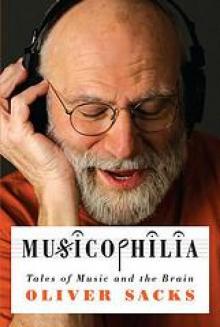 Musicophilia
Musicophilia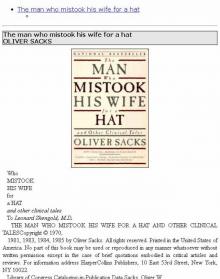 The man who mistook his wife for a hat
The man who mistook his wife for a hat 1989 - Seeing Voices
1989 - Seeing Voices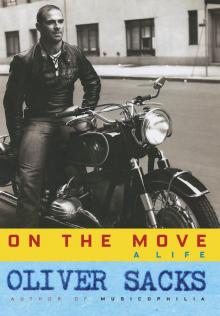 On the Move: A Life
On the Move: A Life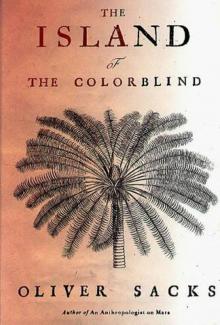 1996 - The Island of the Colorblind
1996 - The Island of the Colorblind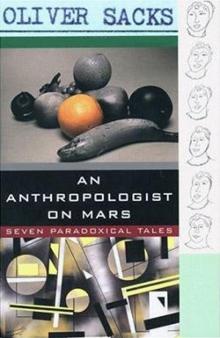 An Anthropologist on Mars: Seven Paradoxical Tales
An Anthropologist on Mars: Seven Paradoxical Tales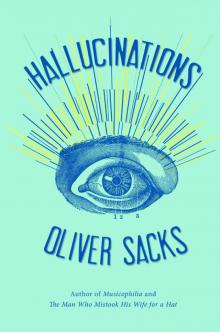 Hallucinations
Hallucinations Seeing Voices
Seeing Voices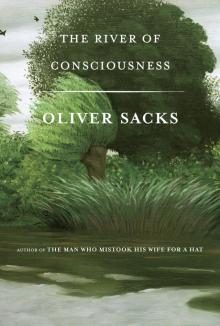 The River of Consciousness
The River of Consciousness Vintage Sacks
Vintage Sacks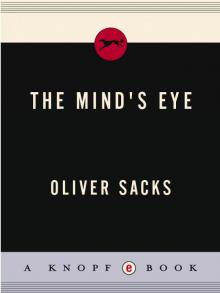 The Mind's Eye
The Mind's Eye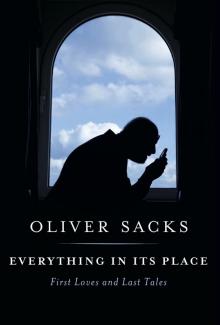 Everything in Its Place
Everything in Its Place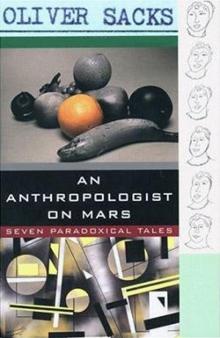 An Anthropologist on Mars (1995)
An Anthropologist on Mars (1995) Uncle Tungsten: Memories of a Chemical Boyhood (2001)
Uncle Tungsten: Memories of a Chemical Boyhood (2001)